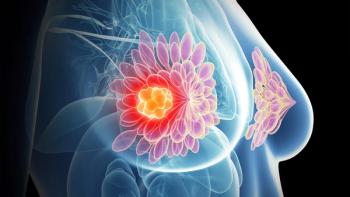
Novel Photodynamic Therapy Provides Durable Responses in NMIBC
Patients with non-muscle invasive bladder cancer treated with the novel photodynamic therapy TLD-1433 experienced 6-, 12-, and 15-month complete response rates of 54%, 38%, and 37%, respectively.
Patients with non-muscle invasive bladder cancer (NMIBC) treated with the novel photodynamic therapy TLD-1433 (Ruvidar) obtained 6-, 12-, and 15-month complete response (CR) rates of 54%, 38%, and 37%, respectively, according to a recent study update.1
This outcome resulted in the phase 2 Study II trial (NCT03945162) meeting its primary and secondary end points.
Among the 63 patients treated to date, 59 were evaluable for the primary performance objective, 46 for the secondary, and 59 for the tertiary. Interim clinical data showed that 64% of patients achieved a CR on 1 or more assessment dates, and the indeterminate response rate was 10%. This translates to a 75% total response rate in the primary evaluation. For the secondary evaluation, the CR and indeterminate response rates were 37% and 4%, for a total response rate of 41%. For the tertiary evaluation, the CR and indeterminate response rates were 100% and 0%, for a total response rate of 100%. Notably, responses for 1 patient at days 270 and 260 were under review at the time of data collection.
In 2020, the FDA granted Theralase fast track designation for TLD-1433 alongside the TLC-3200 laser system in Study II, which is evaluating the regimen in patients with BCG-unresponsive NMIBC with carcinoma in situ (CIS).2 Pending approval, the Study II treatment could be the first intravesical, patient-specific, light-activated, ruthenium-based photodynamic compound for the treatment of patients with BCG-unresponsive NMIBC with CIS, with or without recurrent or resected papillary Ta/T1 tumors.1
Study II is an open-label, single-arm, multicenter trial being conducted in Canada and the United States. To quality as BCG unresponsive, patients must have received at least 5 doses of an initial induction course plus at least 2 of 3 doses of maintenance therapy, or have received at least 5 of 6 doses of an initial induction regimen plus at least 2 of 6 doses of a second induction regimen. Disease relapse within 12 months after completing the second course of BCG therapy also categorizes patients as BCG unresponsive.3
Eligible patients will receive 2 photodynamic therapy treatments of TLD-1433 at 0.70 mg/cm2, which will be administered intravesically at day 0 and day 180.
In this study, an indeterminate response was defined as negative cystoscopy and positive urine cytology.1
The primary and secondary end points of the trial are the CR rate at any point in time and the duration of CR at 360 days post-initial CR.2
Additionally, patients were assessed at day 90 (n = 59), 180 (n = 57), 270 (n = 54), 360 (n = 52), and 450 (n = 46) days. The respective total response rates at these time points were 63% (CR, 56%; indeterminate response, 7%), 72% (CR, 54%; indeterminate response, 18%), 56% (CR, 43%; indeterminate response, 13%), 44% (CR, 38%; indeterminate response, 6%), and 41% (CR, 37%; indeterminate response, 4%).1
In 2016, the International Bladder Cancer Group published consensus guidelines in the Journal of Clinical Oncology recommending the relevance of single-arm trial designs for patients with BCG-unresponsive bladder cancer. In the publication, they recommend a clinically meaningful CR rate for CIS or recurrence-free rate for papillary tumors of at least 50% at 6 months, 30% at 12 months, and 25% at 18 months.4
Interim data for patients who received the optimized Study II treatment after August 1, 2020, were also presented for days 90, 180, 270, 360, and 450. Here, the respective total response rates were 68% (CR, 62%; indeterminate response, 6%), 79% (CR, 60%; indeterminate response, 19%), 59% (CR, 45%; indeterminate response, 14%), 48% (CR, 40%; indeterminate response, 7%), and 44% (CR, 39%; indeterminate response, 6%).1
Notably, more than 80% of patients remained on trial after 90 days following receipt of Study II therapy. Among all evaluable patients, 41% of responders and 37% of complete responders had a duration of response (DOR) lasting 450 days or more. Among evaluable patients who received optimized therapy, 44% of all responders and 39% of complete responders had a DOR lasting at least 450 days.
Regarding safety, serious adverse effects included 2 grade 2 events, 7 grade 3 events, 3 grade 4 events, and 1 grade 5 event, none of which were deemed related to the Study II drug or Study II Device. Except for an unknown resolution status for one of the grade 3 events, all events were resolved.
In 2023, Theralase submitted a pre-breakthrough therapy designation (pre-BTD) request to the FDA. Based on FDA feedback, the company is working with clinical study sites, a central pathology organization, a biostatistics organization, and a regulatory consulting organization to revise the pre-BTD with clinical data clarifications. The company expects to resubmit the pre-BTD submission to the FDA in the first quarter of 2024 for FDA review. Once the pre-BTD submission has been accepted by the FDA, the company plans to submit a BTD application to the FDA.
Completion of enrollment and delivery of the primary Study II Treatment for all patients in 2024 as intended would result in a clinical data lock in mid-2026 with a potential Health Canada and FDA approval by 2026 or 2027.
References
- Theralase(R) provides update on phase II bladder cancer clinical study. News release. Theralase Technologies. January 15, 2024. Accessed January 17, 2024.
https://www.biospace.com/article/releases/theralase-r-provides-update-on-phase-ii-bladder-cancer-clinical-study/ - Theralase granted FDA fast track designation for NMIBC phase II clinical study. News release. Theralase. November 23, 2020. Accessed January 17, 2024.
https://theralase.com/theralase-granted-fda-fast-track-designation-for-nmibc-phase-ii-clinical-study/ - Intravesical photodynamic therapy (“PDT”) in BCG-unresponsive/intolerant non-muscle invasive bladder cancer (“NMIBC”) patients. ClinicalTrials.gov. Updated May 1, 2023. Accessed January 17, 2024.
https://classic.clinicaltrials.gov/ct2/show/NCT03945162 - Kamat AM, Sylvester RJ, Bohle A, et al. Definitions, end points, and clinical trials designs for non-muscle-invasive bladder cancer: recommendations from the International Bladder Cancer Group. J Clin Oncol. 2016;34(16):1935-1944. doi:10.1200/JCO.2015.64.4070
Newsletter
Knowledge is power. Don’t miss the most recent breakthroughs in cancer care.
















































































